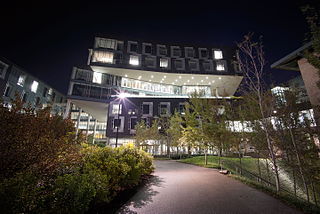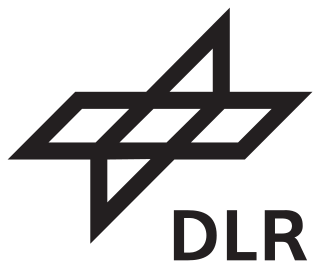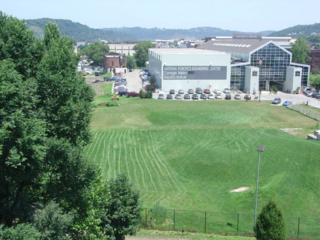
Jet Propulsion Laboratory (JPL) is a federally funded research and development center in La Cañada Flintridge, California, United States. Founded in 1936 by Caltech researchers, the laboratory is now owned and sponsored by the National Aeronautics and Space Administration (NASA) and administered and managed by the California Institute of Technology.
The Fraunhofer Society is a German research organization with 76 institutes spread throughout Germany, each focusing on different fields of applied science. With some 30,800 employees, mainly scientists and engineers, and with an annual research budget of about €3.0 billion, it is the biggest organization for applied research and development services in Europe. It is named after Joseph von Fraunhofer who, as a scientist, an engineer, and an entrepreneur, is said to have superbly exemplified the goals of the society.

The School of Computer Science (SCS) at Carnegie Mellon University in Pittsburgh, Pennsylvania, US is a school for computer science established in 1988. It has been consistently ranked among the top computer science programs over the decades. As of 2022 U.S. News & World Report ranks the graduate program as tied for second with Stanford University and University of California, Berkeley. It is ranked second in the United States on Computer Science Open Rankings, which combines scores from multiple independent rankings.
Draper Laboratory is an American non-profit research and development organization, headquartered in Cambridge, Massachusetts; its official name is The Charles Stark Draper Laboratory, Inc. The laboratory specializes in the design, development, and deployment of advanced technology solutions to problems in national security, space exploration, health care and energy.
The Centennial Challenges are NASA space competition inducement prize contests for non-government-funded technological achievements by American teams.

The Robotics Institute (RI) is a division of the School of Computer Science at Carnegie Mellon University in Pittsburgh, Pennsylvania, United States. A June 2014, the article in Robotics Business Review magazine calls it "the world's best robotics research facility" and a "pacesetter in robotics research and education."

The German Aerospace Center is the national center for aerospace, energy and transportation research of Germany, founded in 1969. It is headquartered in Cologne with 35 locations throughout Germany. The DLR is engaged in a wide range of research and development projects in national and international partnerships.
Thomas Baker Slick Jr. was a San Antonio, Texas-based inventor, businessman, adventurer, and heir to an oil business. Slick's father, Thomas Baker Slick Sr., a.k.a. "The King of the Wildcatters", had made a fortune during the Oklahoma oil boom of the 1910s. He was notable for discovering Oklahoma's then-largest oil field, the Cushing Oil Field.

The Office of Naval Research (ONR) is an organization within the United States Department of the Navy responsible for the science and technology programs of the U.S. Navy and Marine Corps. Established by Congress in 1946, its mission is to plan, foster, and encourage scientific research to maintain future naval power and preserve national security. It carries this out through funding and collaboration with schools, universities, government laboratories, nonprofit organizations, and for-profit organizations, and overseeing the Naval Research Laboratory, the corporate research laboratory for the Navy and Marine Corps. NRL conducts a broad program of scientific research, technology and advanced development.

Interstellar Boundary Explorer is a NASA satellite in Earth orbit that uses energetic neutral atoms (ENAs) to image the interaction region between the Solar System and interstellar space. The mission is part of NASA's Small Explorer program and was launched with a Pegasus-XL launch vehicle on 19 October 2008.

Science and technology in Japan has helped fuel the rapid industrial and economic development of the country. Japan has a long history and tradition for scientific research and development, stretching as far back as the Meiji period.
The United States Army DEVCOM Ground Vehicle Systems Center (GVSC) (formerly United States Army Tank Automotive Research, Development and Engineering Center (TARDEC)), located in Warren, Michigan, is the United States Armed Forces' research and development facility for advanced technology in ground systems. It is part of the U.S. Army Combat Capabilities Development Command (DEVCOM), a major subordinate command of the U.S. Army Futures Command. GVSC shares its facilities with the United States Army Tank-automotive and Armaments Command (TACOM). Current technology focus areas include Ground Vehicle Power and Mobility (GVPM), Ground System Survivability and Force Protection, among others.

The advanced Stirling radioisotope generator (ASRG) is a radioisotope power system first developed at NASA's Glenn Research Center. It uses a Stirling power conversion technology to convert radioactive-decay heat into electricity for use on spacecraft. The energy conversion process used by an ASRG is significantly more efficient than previous radioisotope systems, using one quarter of the plutonium-238 to produce the same amount of power.
NASA spin-off technologies are commercial products and services which have been developed with the help of NASA, through research and development contracts, such as Small Business Innovation Research (SBIR) or STTR awards, licensing of NASA patents, use of NASA facilities, technical assistance from NASA personnel, or data from NASA research. Information on new NASA technology that may be useful to industry is available in periodical and website form in "NASA Tech Briefs", while successful examples of commercialization are reported annually in the NASA publication Spinoffs. The publication has documented more than 2,000 technologies over time.

MAHLE Powertrain Ltd is the engineering services division of MAHLE GmbH. With its headquarters in Northampton, UK and sister company in Plymouth, Michigan, United States, the company specialises in the design, development and testing of electrified powertrain systems and provides a broad spectrum of engineering services to its global customer base. MAHLE Powertrain's engineers and technical specialists are also present in the MAHLE research and development centres in Munich, Germany and Shanghai, China.

The National Robotics Engineering Center (NREC) is an operating unit within the Robotics Institute (RI) of Carnegie Mellon University. NREC works closely with government and industry clients to apply robotic technologies to real-world processes and products, including unmanned vehicle and platform design, autonomy, sensing and image processing, machine learning, manipulation, and human–robot interaction.
Sunil K. Agrawal is an Indian roboticist and professor of Fu Foundation School of Engineering and Applied Science with secondary appointment in Rehabilitation and Regenerative Medicine at Columbia University. Agrawal is the author of more than 500 journals, three books, and has 15 U.S. patents.
Polarimeter to Unify the Corona and Heliosphere (PUNCH) is a future mission by NASA to study the unexplored region from the middle of the solar corona out to 1 AU from the Sun. PUNCH will consist of a constellation of four microsatellites that through continuous 3D deep-field imaging, will observe the corona and heliosphere as elements of a single, connected system. The four microsatellites were initially scheduled to be launched in October 2023, but they have since been moved to an April 2025 launch in rideshare with SPHEREx.

Shuttle-Centaur was a version of the Centaur upper stage rocket designed to be carried aloft inside the Space Shuttle and used to launch satellites into high Earth orbits or probes into deep space. Two variants were developed: Centaur G-Prime, which was planned to launch the Galileo and Ulysses robotic probes to Jupiter, and Centaur G, a shortened version planned for use with United States Department of Defense Milstar satellites and the Magellan Venus probe. The powerful Centaur upper stage allowed for heavier deep space probes, and for them to reach Jupiter sooner, prolonging the operational life of the spacecraft. However, neither variant ever flew on a Shuttle. Support for the project came from the United States Air Force (USAF) and the National Reconnaissance Office, which asserted that its classified satellites required the power of Centaur. The USAF agreed to pay half the design and development costs of Centaur G, and the National Aeronautics and Space Administration (NASA) paid the other half.

Andrew John Stofan is an American engineer. He worked for the National Aeronautics and Space Administration (NASA) at the Lewis Research Center. In the 1960s he played an important role in the development of the Centaur upper stage rocket, which pioneered the use of liquid hydrogen as a propellant. In the 1970s he managed the Atlas-Centaur and Titan-Centaur Project Offices, and oversaw the launch of the Pioneer 10 and Pioneer 11 probes to Jupiter and Saturn, the Viking missions to Mars, Helios probes to the Sun, and the Voyager probes to Jupiter and the outer planets. He was director of the Lewis Research Center from 1982 to 1986.












